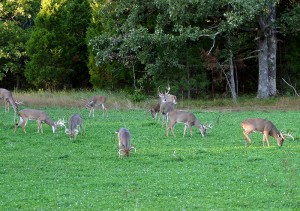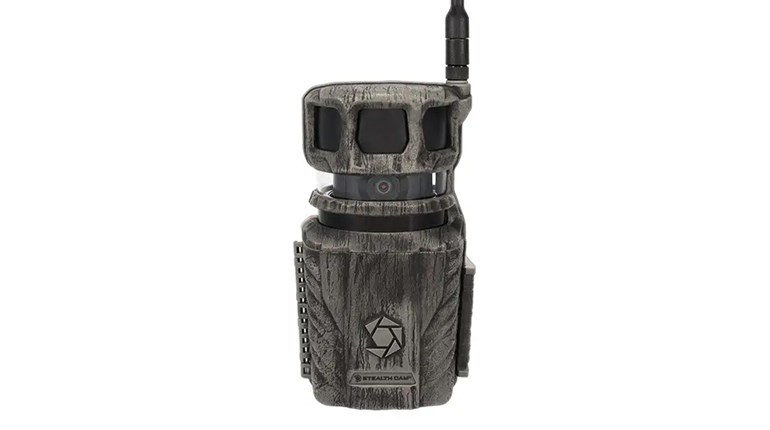Sure, there’s luck involved in all successful hunts, but some hinge on it more than others. We’ve all heard of the fair-weather hunter who blunders into the woods an hour late only to be nearly run over by a wall-hanger. Many more success stories, however, involve huge amounts of preparation and patience to leverage what luck is given. Generally, the hunters who consistently take mature whitetails are more than lucky.
What follows is not a cleverly disguised advertisement, but a real story of an average American hunter who helped forge his own luck despite tough environmental conditions. It happens thousands of times around the country. Next year it could be you, but it’s not likely if you don’t start planning now.
Brad Gaddis, of Ada, Okla., considers himself a serious whitetail hunter, and by modern standards he is—just ask his fiancée. This 30-year-old owner of a landscaping company spends approximately 150 days per year hunting, scouting or prepping properties he leases exclusively for deer hunting. He partners with hunting buddies who share his management goals so they can split costs. Gaddis is not foreign to big bucks—he killed a 165-class deer a few years back—but his secrets are not so secret: He hunts areas that have big-buck potential, plants food plots to improve the herd’s nutrition, monitors trail cams, hunts when the conditions are right and passes up small bucks. Practicing this discipline in southwest Oklahoma, like most free-range places in the country, means that many years he doesn’t shoot a buck at all. Fortunately for Gaddis, last year was not one of them.
In 2011, Oklahoma, like the entirety of the Southwest including most of Texas, faced its worst drought in at least 50 years. Ponds dried up, wildfires destroyed lives, farmers filed for bankruptcy and millions of trees—even ancient oaks—shriveled up and died. Trees that held on produced no mast. Deer and wildlife had to look for other food sources. Many of them perished, and the ones that made it had few surplus nutrients for antler production. Anticipating this, Gaddis called the Whitetail Institute hotline and asked company reps what he could do to hedge his property’s deer, if not his deer season.
Whitetail Institute’s in-house expert, William Cousins, suggested several different products along with specific planting instructions. He strongly suggested Gaddis conduct a soil-pH test, and warned that if there was no rain immediately after the suggested late-September to early-October planting window, the effort and money spent could be a total waste.
Sometimes it’s better to be lucky than good.
“I received my seed in the mail around September 1,” recalled Gaddis. “I prepped the ground but was forced to wait a few days for the weather to cooperate.” He finally got the seed in the ground Sept. 15 then crossed his fingers.
Gaddis’ food plot was a modest 5-acre meadow surrounded by thick woods. Rather  unconventionally, he planted a variety of Whitetail Institute’s products there, including Imperial Whitetail Forage Oats, Pure Attraction and “Chic” Magnet. “I was fortunate enough to get a timely rain, and by October 1 the oats started to sprout and the deer immediately started moving in,” he said.
unconventionally, he planted a variety of Whitetail Institute’s products there, including Imperial Whitetail Forage Oats, Pure Attraction and “Chic” Magnet. “I was fortunate enough to get a timely rain, and by October 1 the oats started to sprout and the deer immediately started moving in,” he said.
Just a few days later, Gaddis noted a couple dozen deer were using the plot on a regular basis, including half a dozen bucks. At midday on Oct. 5, he ventured to the edge of the plot to check his camera. Although shrouded by haze induced from nighttime camera flash, the images on the camera’s memory card revealed a large buck as it entered the plot and fed.
“The buck was a long way from the camera and hard to make out,” said Gaddis, “so I didn’t realize exactly how big he was.” Regardless, a potential shooter excited him. He’d heard county-wide reports from peers and local forums that antler production was way down. Few hunters he knew had even spotted a quality buck. He slipped out of the woods with renewed hope for the drought-stricken season.
He returned two days later to check the camera. This time it had captured some really good photos. Clearly the buck was a monster, with non-typical points jutting from all angles in a starburst pattern. Gaddis had hunted the property for several years but hadn’t seen this buck before, or anything remotely like him. The deer was obviously healthy, gorging on the high-protein forage, and looked like his antler growth had been in overdrive.
“My initial thought was that he was at least 200 inches—incredible for any year, but especially this year. He was by far the largest buck I’d ever hunted,” said Gaddis. Though he was ready to begin his quest, the wind didn’t cooperate for his stand location for the next full week, so Gaddis remained patient, opting to stay out of the area. As anyone who has a hunted a big buck knows, this is sometimes the most challenging—and important—aspect of the hunt.
Gaddis continued to monitor trail cam photos, and was amazed and emboldened when they showed the buck mowing down the plot every single night. Finally, on Oct. 12, the wind switched in his favor.
“I hunted every day from October 12 to October 25 without ever sighting him—which didn’t surprise me that much because I knew he was feeding at night. I passed several nice bucks in the 140- to 150-class range during this time,” said Gaddis.
By now, the 30-year-old business owner was fully consumed. “Brad lost his mind for  almost a month,” said Gaddis’ fiancée, Loren. “He could barely form sentences. I rarely saw him in person at all.”
almost a month,” said Gaddis’ fiancée, Loren. “He could barely form sentences. I rarely saw him in person at all.”
Oklahoma’s primitive arms season began Oct. 26, so in a rare move Gaddis hung up the bow in favor of the longer-reaching blackpowder rifle. He hunted the next two days without spotting the buck. It was at this time he realized he needed to make a tactical change, because the buck, while stuck on the food source, was too wary to enter it during daylight.
“I decided to move back into the timber to cut him off as he headed to the Whitetail Institute plot to feed,” said Gaddis. “I hung a new stand on a creek bank where I knew he had to be traveling, and I continued hunting with my rifle.” Gaddis was still getting pictures of the giant deer every night, but the deer was extremely nocturnal. Then, something changed.
On Nov. 1, Gaddis had his first encounter when he glimpsed non-typical antlers that sprouted from the deer’s head like a crazy coat rack. The mesmerized hunter struggled to even count all its points as the buck cruised by him swiftly in the thick timber behind the food plot.
“By the time I realized it was him, he’d vanished back into the woods,” said Gaddis. “But I knew I was getting close at this point, because bucks were starting to chase and he was finally up on his feet during shooting hours.”
Like a wild-eyed hound closing in on the track, Gaddis hunted through the last day of blackpowder season. During this time he had several more encounters with the deer that kept him up day and night. Keep in mind, fellow big-buck fanatics: By now he’d hunted this deer for 22 days straight. Gaddis was exhausted, mentally and physically, as were his friends and family—as some of you can relate. It was beginning to get to him. Mercifully, he decided to take a day off.
On Nov. 4 Gaddis slept in, but his sleep was made restless by pangs of self-doubt. By mid-morning, he had to know. So he tiptoed onto the property at midday to check the camera. You guessed it: At exactly 9:30 that morning, the buck was photographed loitering directly under the hunter’s stand for 45 minutes with a doe.
“I was sick to my stomach,” recalled Gaddis. “But now that I knew he was with a hot doe, I liked my odds. The does were really piling into the food plot at this point, and it was holding them there, so I figured this was my best—and maybe my only—real chance to put the buck on the ground.”
The next morning Gaddis grabbed his Mathews Z7 and snuck into his stand much earlier than normal—a full hour before sunup. It was a still, cold November day. A finer day could not be painted in a deer hunter’s dream. As the sun began to break the horizon, Gaddis heard heavy hoof prints on the oak leaves. He raised his binocular and saw legs through the brush, headed his way. As they marched closer he realized it was a doe, and then, just behind her, he caught more movement. And there he was, following her closely, coming down the same trail—the trail that passed by his stand.
“I rose to my feet, bow at the ready, and waited for the shot,” said Gaddis. “I let him get as close as possible, and when he walked into one of my shooting lanes I grunted.”
The giant whitetail stopped in his tracks. Gaddis says it all happened too fast for him to become overly nervous. On autopilot, he drew, held and centered his pin behind the mighty buck’s exposed left shoulder as it quartered away slightly. With a thunk, his arrow flew.
“I knew immediately I’d hit him good,” he said. “I watched as he ran, thrashing through the timber, until he was out of sight.” It was 7:30 in the morning.
Not about to become impatient now, the adrenaline-charged bowhunter let the arrowed buck sit for an hour before starting in on the blood trail. (Loren reports it was more like 20 minutes, based on his phone calls.) At any rate, Gaddis didn’t have to go far. The hunter found the Oklahoma behemoth lying stone-dead, less than 100 yards from his stand.
As he approached the deer, Gaddis let out a victory yell.
“I hadn’t just killed the biggest buck of my life,” he said, “but probably the biggest buck I’ll ever see.”
Only after he wrapped his hands around the buck’s antlers could he appreciate just how big it was. After several attempts, he counted 29 or 30 points. The buck officially netted 2125/8 B&C inches and was estimated at 5 1/2 to 6 1/2 years old—a fact that’s pointless now that the buck will live eternally on Gaddis’ wall.
There are bigger bucks taken each year around the country, no doubt. But for Brad Gaddis, in this particular year in southwest Oklahoma, this is the best buck in the history of the world, and for that, he knows he’s extremely lucky.




































